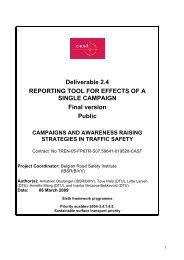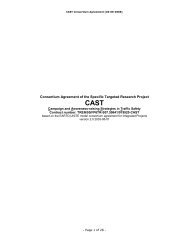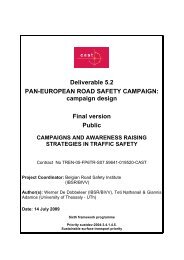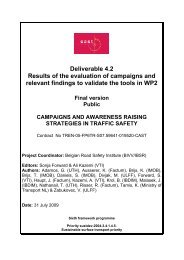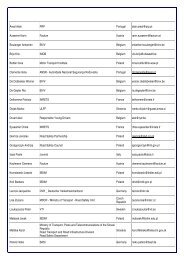Deliverable D 1.3 RESULTS OF META-ANALYSIS ... - cast-eu.org
Deliverable D 1.3 RESULTS OF META-ANALYSIS ... - cast-eu.org
Deliverable D 1.3 RESULTS OF META-ANALYSIS ... - cast-eu.org
You also want an ePaper? Increase the reach of your titles
YUMPU automatically turns print PDFs into web optimized ePapers that Google loves.
Campaigns and awareness raising strategies in traffic safety — <strong>Deliverable</strong> D-1.1the overlap between confidence intervals this difference is not significant. Theresults are presented in Table 7.22 after accounting for publication bias.Table 7.22. Overall effect of safety campaigns according to publication source of study, afteraccounting for publication bias. Each overall effect is based on n individual effects (excludingany artificial effects generated by trim-and-fill).AccidentsSeatbelt usepublication routeeffect(%)95%confidenceinterval (%)nSig.?(p < 0.05)effect(%)95%confidenceinterval (%)nSig.?(p < 0.05)refereed journal -18 (-26;-9) 21 yes +22 (+16;+29) 95 yesinstitute report -9 (-14;-4) 72 yes +11 (-14;+43) 27 noLittle or no publication bias was detected for the accident effects publishedeither in refereed journals or institute reports. The lack of bias apparent for theeffects from refereed journals might be because only 21 effects were availablefor testing by trim-and-fill.Bias was, however, detected for those seatbelt use effects published inrefereed journal articles, with the overall effect reduced from a 53 per centincrease in seatbelt use to just 22 per cent after accounting for bias. However,bias was also detected among those effects published in accessed institutereports, with campaigns coinciding with an overall increase in belt use of just11 per cent after accounting for bias, compared with 37 per cent before. It isnot clear why results published in institute reports should be biased. Oneexplanation is that the accessibility of institute reports is influenced by theeffect sizes they report. Another is that there is another explanation forskewness. In our conservative approach we simply make an assumption thatthere is publication bias.It is conceivable that campaign effectiveness varies over time. For example,the campaigns carried out today might be more effective because they arebased on greater knowledge, or there might be professional or technologicaladvances that make television campaigns or posters more effective. In orderto test for any change in overall campaign effectiveness over time, the effectswere grouped according to the decade in which the studies that reported themwere published, and the overall effects in each group presented in Table 7.23.73



